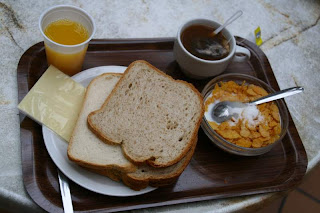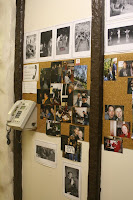
Heard a touching tale, rather lovingly told, by our Scottish bus driver. Realised I had not taken a picture of Bobby, and had to spend the last few minutes in Edinburgh hurtling up and down the steep slopes to locate and click the pix - and run to Waverly to catch the train!
The sum and substance of it:
Clever wee dog works with his master, a policemen, and is a general boon to his owner. Sadly, owner dies, but dog sits on his Master's grave "guarding" it. Villains try to get rid of said dog, but dog is gutsy and tenacious. Dog wins friends, becomes well known and has many adventures.
Believe a film was made some years back, around this story...must see it.

ps: The statue in the photo looks big, but is actually a wee one. You'd surely miss it unless you kept a sharp eye for it. Do not miss Bobby's grave in the Greyfriars Church next door either, with a nice tombstone ( Click on the picture for an enlarged version).
Here's a little more: extracted from the net, for those who want a better flavour:
Policeman, John Gray, acquired his world-famous Skye terrier sometime about 1856 or so, as a watch-dog. Man and dog became inseparable, until two years later, when Gray died of tuberculosis. It was then, Bobby began his lengthy, grave-side vigil.
The diminutive tombstones are obviously tended with great devotion.
A tradition closely bound to Greyfriars Bobby and Edinburgh castle is the firing of the one o'clock gun. The legend tells of a sea captain who visited Edinburgh back in the 1860's. When he returned home, he reported that he had just seen a wonderful city, full of splendid buildings and monuments, where wise men and lovely ladies lived and where science was studied. There was only one problem; no one knew the correct time of day. There were plenty of clocks, but no two agreed.
In 1861, the situation was put right, when city officials decided to fire a cannon every day from the castle grounds, at exactly one o'clock. Thus, all the citizens could set their clocks accordingly.
About the time this tradition began, Greyfriars Bobby had been befriended by a soldier in the castle garrison, by the name of Scott. Sergeant Scott introduced Bobby to his companions and everyone welcomed their new furry comrade. One of the Sergeant Scott's responsibilities was to assist in setting off the cannon and Bobby always followed him to the ramparts to witness the action.
A sketch of this daily event was drawn at the time by an artist and printed in a popular magazine called Good Words which was read all over the English-speaking world. In the sketch, Bobby can be seen, apparently unafraid and eagerly
waiting for the big boom. In fact, Bobby was use to loud noises and considered quite brave for his small size. When the pipes and drums played on the parade grounds, Bobby pranced along.
Immediately after the one o'clock gun, Bobby would come trotting out and head for a restaurant called the Eating House, ( Perhaps it is this Eating Hiuse, now sporting Bobby's name that you see in the background of thepicture) where the proprietor regularly gave Bobby his lunch. It soon became a daily attraction to watch Bobby go for his dinner and a crowd frequently collected at the gates of the kirkyard to wait for him. But Bobby did not linger long over his food. As soon as he was finished, he raced off to the cemetery to sit patiently by John Grey's grave.
Because Greyfriar's Bobby is a cherished part of the Edinburgh story, his collar and dinner dish are preserved in the Huntly House.

 Stern is very much in the news, and does seem to be very hot property days after his climate economics report. Have his session this afternoon. Stern is also the Academic Patron of the Gurukul programme, and Lord Desai was one of the prime movers of this scholarship at the inception stage.
Stern is very much in the news, and does seem to be very hot property days after his climate economics report. Have his session this afternoon. Stern is also the Academic Patron of the Gurukul programme, and Lord Desai was one of the prime movers of this scholarship at the inception stage.
















































